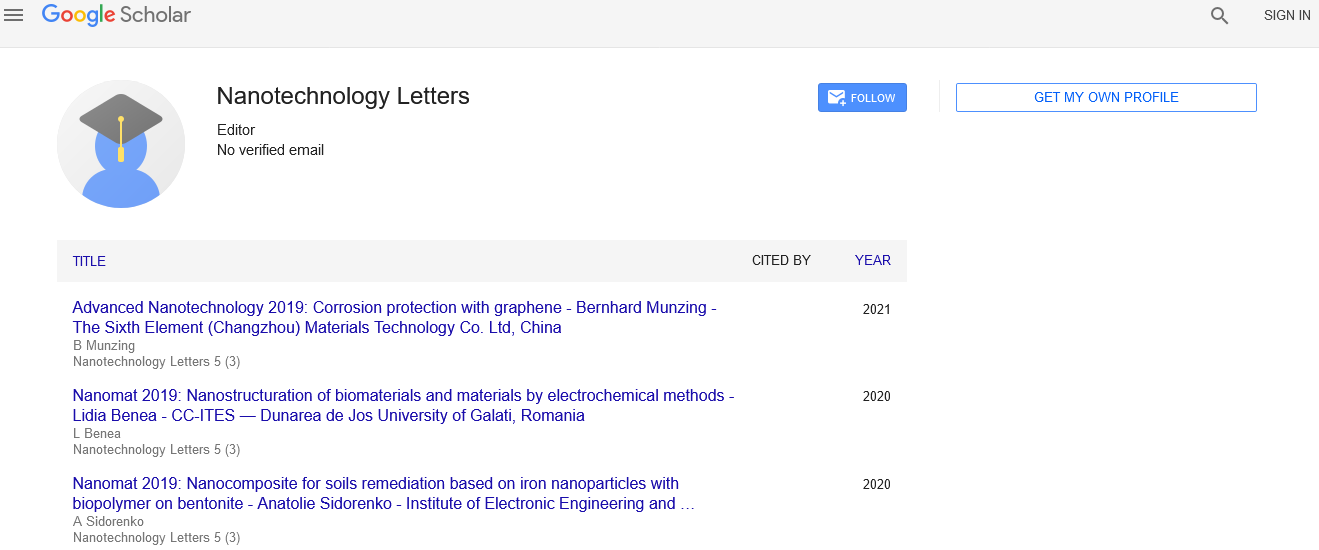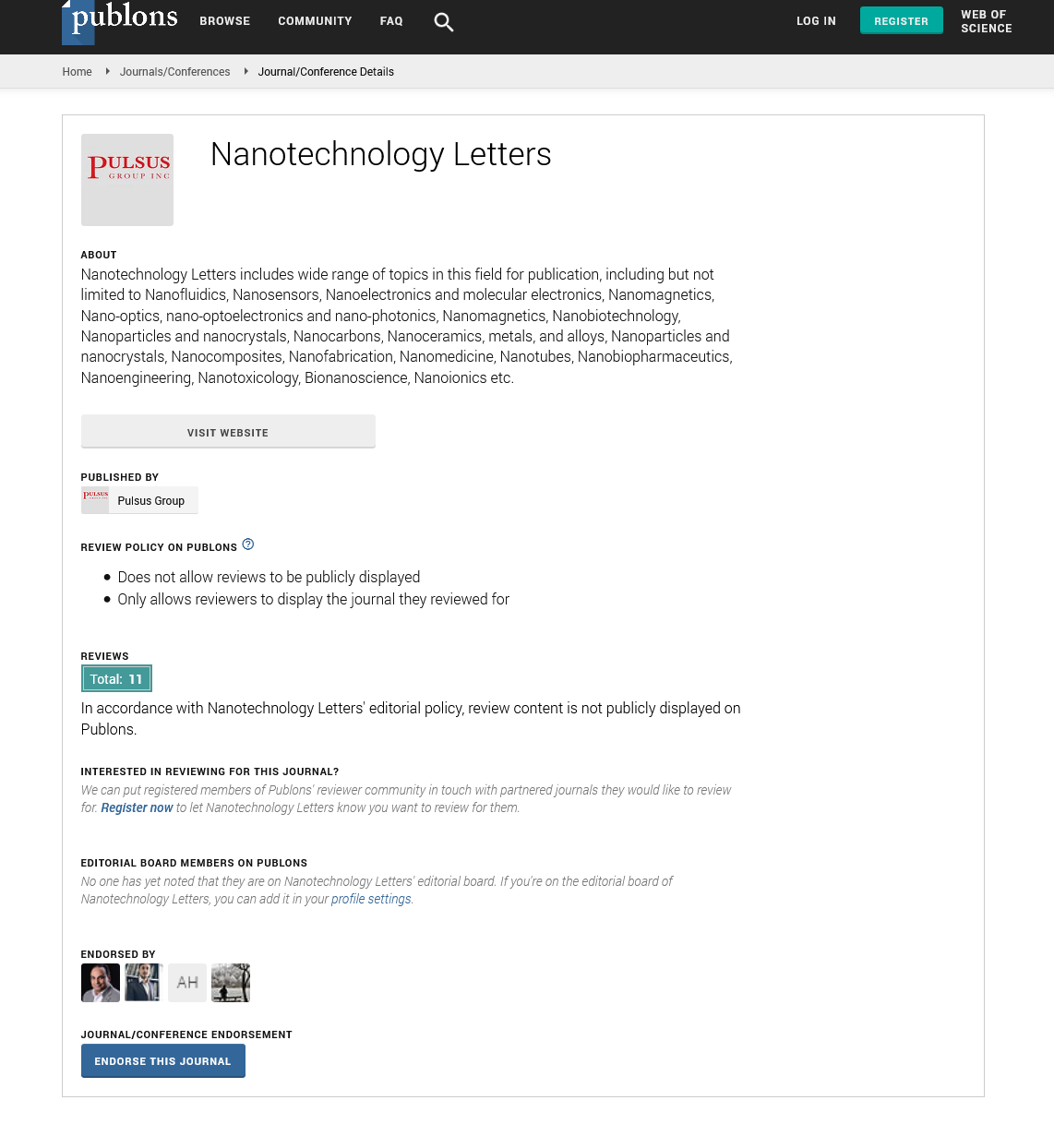Expanding growth of the nanomedicine industry through enhanced pharmacy training
Received: 08-Jun-2023, Manuscript No. pulnl-23-6809; Editor assigned: 12-Jun-2023, Pre QC No. pulnl-23-6809 (PQ); Accepted Date: Jun 26, 2023; Reviewed: 15-Jun-2023 QC No. pulnl-23-6809 (Q); Revised: 25-Jun-2023, Manuscript No. pulnl-23-6809 (R); Published: 28-Jun-2023
Citation: Hoffman. A. Expanding growth of the nanomedicine industry through enhanced pharmacy training. Nanotechnol. lett.; 8(3):42-43
This open-access article is distributed under the terms of the Creative Commons Attribution Non-Commercial License (CC BY-NC) (http://creativecommons.org/licenses/by-nc/4.0/), which permits reuse, distribution and reproduction of the article, provided that the original work is properly cited and the reuse is restricted to noncommercial purposes. For commercial reuse, contact reprints@pulsus.com
Abstract
The evolving realm of nanomedicine encompasses a diverse array of active pharmaceutical ingredients and drug formulations, conferring unique properties that augment both pharmacokinetics and pharmacodynamics. These nanomedicines are crafted using manufacturing techniques rooted in biotechnology or traditional methods, setting them apart significantly from conventional smallmolecule drugs. The research and clinical application of these innovative treatments rely on a multidisciplinary team of scientists, including pharmacists who assume a pivotal role. Consequently, pharmacy education should equip them with the understanding of the intricate challenges associated with the development and evaluation of nanomedicines. Hence, it is imperative to offer additional exposure to this swiftly advancing category of therapeutics for trainees, postdoctoral researchers, and student pharmacists.
Key Words
Nanomedicine; Pharmacy; Pharmacist; Nanoparticles
Introduction
During the late 1990s, the rapid advancements in nanotechnology and nanomaterial science led to the emergence of nanomedicine as a distinct scientific discipline. Notably, in the United States, over half of the currently approved nanomedicines received their licenses within the past decade, underscoring the explosive growth of these novel pharmacological treatments [1]. Nanomedicines are purposefully designed to overcome biological barriers and offer tailored pharmacokinetic and pharmacodynamics profiles to enhance safety and therapeutic effectiveness, setting them apart from their small-molecule parent medications. Nevertheless, the field of nanomedicine still grapples with various challenges and knowledge gaps, including the optimal definition of these substances, the intricate assessment of their pharmacokinetics and bio distribution profiles, and the comparison of their costeffectiveness with that of small-molecule drugs [2].
Among healthcare practitioners, pharmacists play a pivotal role in both fields. They are involved in making clinical decisions and managing the administrative aspects of using nanomedicines. Their training equips them with a deep understanding of the fundamental principles underlying this complex class of therapeutics [3]. The ongoing development of nanomedicines necessitates an innovative, forward-thinking approach to incorporate nanomedicine content into pharmacy curricula, pharmacy administration, and pharmacy education.
INTEGRATION OF NANOMEDICINE INTO PHARMACY EDUCATION
One rapidly advancing sector in pharmaceutical development involves engineered nanomaterials, which possess the capability to surmount various biological limitations. The pharmaceutical market is poised for significant growth, with an increasing emphasis on the development of nanomedicines tailored for the treatment of complex diseases in clinical settings, including immunotherapy and genomerelated conditions.
To meet the evolving demands and challenges in their professional practices and research endeavors, present and future pharmacists must gain a more profound understanding of nanotechnology [4]. Essentially, the ongoing educational reform in professional pharmacy programs aims to merge fundamental science and clinical science education, enabling students and trainees to apply concepts seamlessly from laboratory research to clinical applications and vice versa. Currently, there is limited information available regarding the extent and pace at which nanotechnology's medical applications are incorporated into existing pharmacy and pharmaceutical sciences curricula [5].
INTERNATIONAL OVERVIEW OF PROSPECTS FOR INTEGRATING EDUCATIONAL CONTENT ON NANOMEDICINE
Studies in pharmacy in the United Kingdom
Pharmacy education has been available in Liverpool since 1849, and Liverpool John Moores University stands as one of the United Kingdom's most longstanding institutions for pharmacy studies.
In collaboration with key stakeholders, the present four-year MPharm program was designed as an evolving integrated curriculum [5]. Consequently, scientific knowledge and skills continue to progress and become increasingly intricate. The core components of the MPharm program, including lectures, laboratory exercises, and workshops, encompass the teaching of nanomedicine formulation techniques, utilizing real-world examples of commercially accessible liposomal formulations[6].
Studies of pharmaceutical sciences in the china
The majority of Chinese colleges and universities currently do not provide standalone nanomedicine courses, but several have incorporated nanomedicine concepts into related courses, such as pharmaceutics and advances in medicine. Many educational institutions offer courses focused on peptides, small molecules, and liposomes. For instance, Capital Medical University's School of Pharmacy houses the Beijing Key Laboratory of Peptide and SmallMolecule Drugs [7, 8].
Some pharmacy students opt for elective courses to support their graduation projects while pursuing master's and doctoral degrees [9]. One such elective course, titled "Liposome Preparation and Assessment of Efficacy," explores innovative administration techniques aimed at improving therapeutic outcomes or mitigating undesirable drug effects [10].
Conclusion
Pharmacy education has traditionally emphasized a strong foundation in pharmaceutical sciences, equipping students with the knowledge and skills necessary to comprehend the physiological, preclinical, and clinical aspects of drug development. However, as nanomedicine has emerged, the gaps between these disciplines have widened, demanding interdisciplinary study and instructional approaches. Consequently, the development of integrated curricula offers a valuable opportunity to bridge these educational gaps for both aspiring pharmacists and research scientists.
The realm of nanomedicine is expanding rapidly, presenting unique challenges due to the complexity of these therapeutic agents. Pharmacists are uniquely positioned to integrate pharmaceutical science, regulatory assessment, and clinical data, making informed decisions for patient care in this context. Given the wide range of diseases and conditions that can benefit from nanomedicines, Doctor of Pharmacy programs should adopt forward-thinking strategies to incorporate and expand nanomedicine coverage within their curricula. Recognizing the constraints of busy pharmacy programs, innovative methods such as co-curricular electives, student-driven initiatives, and certificate programs can effectively deliver didactic education on essential nanomedicine concepts.
References
- Wacker MG. Nanotherapeutics—Product development along the “nanomaterial” discussion. J Pharm Sci.2014;103(3):777-84.. [Google scholar] [Cross ref]
- Mitchell MJ, Billingsley MM, Haley RM, et al. Engineering precision nanoparticles for drug delivery. Nat Rev Drug Discovery. 2021;20(2):101-24. [Google scholar] [Cross ref]
- Duncan R, Gaspar R. Nanomedicine (s) under the Microscope Mol Pharmaceutics. 2011;8:2101-41. [Google scholar] [Cross ref]
- Papadopoulos V, Goldman D, Wang C, et al. Looking ahead to 2030: Survey of evolving needs in pharmacy education. Pharmacy. 2021;9(1):59. [Google scholar] [Cross ref]
- Marques M, Choo Q, Ashtikar M, et al. Nanomaterials-Tiny particles and big challenges. [Google scholar] [Cross ref]
- Weissig V, Elbayoumi T, Fluhmann B, et al. The growing field of nanomedicine and its relevance to pharmacy curricula. Am J Pharm Educ. 2021;85(8). [Google scholar] [Cross ref]
- Hertig JB, Shah VP, Flühmann B, et al. Tackling the challenges of nanomedicines: are we ready? Am J Health-Syst Pharm. 2021;78(12):1047-56. [Google scholar] [Cross ref]
- Greene JM, Fuller KA, Persky AM. Practical tips for integrating clinical relevance into foundational science courses. Am J Health-Syst Pharm. 2018; 825 [Google scholar] [Cross ref]
- Brown KP, Raccor BS, Hilgers RH, et al. Interdisciplinary pharmaceutical sciences activity within a pharmacy practice skills course. Curr Pharm Teach Learn 2019;11(3):270-76. [Google scholar] [Cross ref]
- Maerten-Rivera JL, Chen AM, Augustine J et al. Co-curriculum implementation and assessment in accredited doctor of pharmacy programs. Am J Pharm Educ. 2020;84(3). [Google scholar] [Cross ref]






